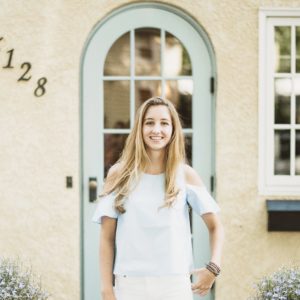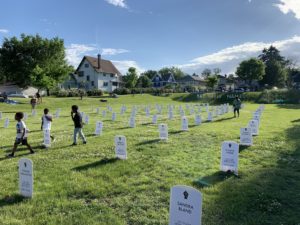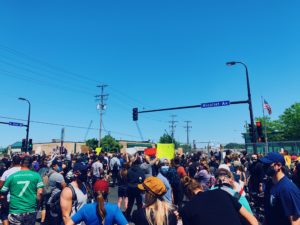Top 5 Stories Worth Reading — August 2024
Aug 29, 2024
Protect the Right to Vote: Be a Poll Worker on Election Day Sign Up Today
 I have lived in the same house my entire life. Two blocks up from Broders’ pasta bar, the yellow house with the baby blue door and the red roof. Queen Avenue is the site of my earliest outdoor expeditions, sneaking in and out of my neighbors bushes to snag fistfuls of fresh raspberries. My neighbors’ lawns were the runway of my first solo bike ride. The tree on the street corner marks the beginning and end of my favorite runs. Growing up on Queen Avenue taught me to always walk barefoot in the summer and never pass up the opportunity to run through a sprinkler. Queen Avenue is why I love the outdoors and advocate for the environment to this day. This place is my family, my friends, and the lens through which I see the world.
I have lived in the same house my entire life. Two blocks up from Broders’ pasta bar, the yellow house with the baby blue door and the red roof. Queen Avenue is the site of my earliest outdoor expeditions, sneaking in and out of my neighbors bushes to snag fistfuls of fresh raspberries. My neighbors’ lawns were the runway of my first solo bike ride. The tree on the street corner marks the beginning and end of my favorite runs. Growing up on Queen Avenue taught me to always walk barefoot in the summer and never pass up the opportunity to run through a sprinkler. Queen Avenue is why I love the outdoors and advocate for the environment to this day. This place is my family, my friends, and the lens through which I see the world.
Five weeks ago, that lens shattered.
Five weeks ago, I was sitting on the front stoop of my house, enjoying a cherry popsicle with my little sister and less than four miles away George Floyd was being suffocated by the knee of police officer Derek Chauvin. As I turned to my sister and read her the joke from my popsicle stick, George Floyd craned his neck and told the police officers, “I can’t breathe.” My sister gave me a sympathy laugh, George Floyd did not get any sympathy at all.
This juxtaposition of experiences is a perfect microcosm of the racial divide in Minneapolis. While I was enjoying a sunny summer day with my younger sister, George Floyd was being racially profiled and violently murdered at the hands of the police. We are two people occupying the same space — a mere four miles apart — and yet each of our lives would be unrecognizable to the other.
It is inexcusable that it took the violent murder of George Floyd in order for me to begin to see the dichotomy between the white and Black experience in Minneapolis. It was not until the protest was literally brought to my front door that I started to question this place I call home. If I am being honest, I was not ignorant before. I noticed the lack of Black people in the spaces I occupied growing up, and I actively chose to ignore the reality. I made excuses because I am able to, that is my white privilege. But I cannot look away anymore. 
The whiteness of my community is not a coincidence. On September 9th, 1948 a racial covenant was written into the warranty deed of the property that would one day become my home. The covenant stated, this property “shall not be sold, leased, mortgaged, used or occupied, nor any right thereto be granted, given or permitted to any person other than a member of the Caucasian race.” I could not live in my house if I was not white, and while the covenant no longer exists, a largely white neighborhood still does.
We cannot begin to address the inequities of the present until we understand the inequities of the past and how we are still contributing to those racist systems. The racial covenants of the 1900s created demographic patterns that still exist in Minneapolis today. While 78 percent of white families own homes in the Twin Cities, only 25 percent of Black families have a title to their residence. This disparity reinforces other inequalities in employment, education, health care and access to outdoor spaces.
So, to all the white people of Minneapolis who — like myself — were shocked at the murder of George Floyd. To everyone who asked themselves, how could such a terrible thing happen in such a “good” place? It is time we relearned what it means to live in Minneapolis. The murder of George Floyd did not come as a shock to the Black community. In fact, the Minneapolis NAACP quite literally saw it coming. In 2015, the NAACP predicted Minneapolis would be the next Ferguson. Nekima Levy-Pounds, the Minneapolis NAACP president, summed up the reality of the situation saying, “the narrative has been that Minneapolis is one of the most livable cities, one of the most literate and one of the most affluent. We’re saying yes, but for white people.”
I am only just beginning the work to relearn the history of my community through a lens that includes systemic racism. This work is not a box to be checked. To be truly anti-racist, I must reaffirm my commitment everyday. As I reflect on my experiences as a resident, student, voter, and environmental advocate in Minneapolis, I must continually question the spaces I occupy. Who else is occupying these spaces? Who is missing? What systems prevent these people from equal access?

Most importantly, I am trying my best to show up. I am showing up for the protests in my community. I am showing up for sit-ins at the Police Department Union. I am showing up to clean-up after marches. I am showing up to raise money for local racial justice groups. I am showing up for the BIPOC-led discussions at my organizations. I am showing up to my newly joined anti-racist book club. I am not leading. There are already Black community leaders who have been long committed to doing this work. But I will continue to show up, and I hope my fellow white environmentalists will join me.